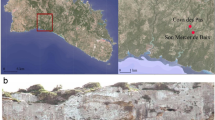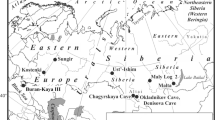Abstract
This article presents the first isotopic investigation of human and animal bone remains from the Middle Chulmun (3500–2000 BC) period in southeastern Korea. We have obtained a single human and associated faunal stable carbon and nitrogen isotope results from the Tongsamdong site, a coastal shell midden. Despite the discovery of domesticated plants and the existence of large amounts of terrestrial mammal bones from the shell midden, the human and dogs we measured were heavily dependent on marine protein resources for their lives. Although our stable isotope results are based on a small number of individuals due to the lack of human remains at this period, isotopic evidence suggests the possibility that Tongsamdong people in the Middle Chulmun period depended largely on marine protein resources. This isotopic evidence is consistent with the archaeological evidence from the site.






Similar content being viewed by others
References
Ambrose SH, Norr L (1993) Experimental evidence for the relationship of the carbon isotope ratios of whole diet and dietary protein to those of bone collagen and carbonate. In: Lambert JB, Grupe G (eds) Prehistoric human bone archaeology at the molecular level. Springer Verlag, pp. 1–38
Bale MT (2001) Archaeology of early agriculture in Korea: an update on recent developments. Bull Indo-pacific Prehist Assoc 21:77–84
Bale MT, Ko M (2006) Craft production and social change in Mumun pottery period Korea. Asian Perspec 45:159–187
Barton L, Newsome SD, Chen F, Wang H, Guilderson TP, Bettinger RL (2009) Agricultural origins and the isotopic identity of domestication in northern China. PNAS 106:5523–5528
Bocherens H, Drucker D (2003) Trophic level isotopic enrichment of carbon and nitrogen in bone collagen: case studies from recent and ancient terrestrial ecosystems. Intl J Osteoarch 13:46–53
Brown TA, Nelson DE, Southon JR (1988) Improved collagen extraction by modified Longin method. Radiocarbon 30:171–177
Cannon A, Schwarcz HP, Knyf M (1999) Marine-based subsistence trend and the stable isotope analysis of dog bones from Namu, British Colombia. J Archaeol Sci 26:399–408
Choe CP, Bale MT (2002) Current perspectives on settlement, subsistence and cultivation in prehistoric Korea. Arctic Anthropol 39:95–121
Choy K, Richards MP (2009) Stable isotope evidence of human diet at the Nukdo shell midden site, South Korea. J Archaeol Sci 36:1312–1318
Choy K, Jeon OK, Fuller BT, Richards MP (2009) Isotopic evidence of dietary variations and weaning practices in the Gaya Cemetery at Yeanri, Gimhae, South Korea. Am J Phys Anthropol (in press). doi:10.1002/ajpa.21202
Crawford GW, Lee G (2003) Agricultural origins in the Korean Peninsula. Antiquity 77:87–95
DeNiro MJ (1985) Postmortem preservation and alteration of in vivo bone collagen isotope ratios in relation to palaeodietary reconstruction. Nature 317:806–809
Ehleringer JR (1991) 13C/12C fractionation and its utility in terrestrial plant studies. In: Coleman DC, Fry B (eds) Carbon isotope techniques. Academic, San Diego, pp 187–200
Ha IS (2001) The analysis of archaeobotanical remains from the Tongsamdong shell midden. Shinsukki Yeonku (Journal of the Korean Neolithic Research) 2:41–49, In Korean
Ha IS (2004) Reviews of Neolithic life in the Tongsamdong shell middens. Shinsukki Yeonku (Journal of the Korean Neolithic Research) 7:77–104, In Korean
Hedges REM, Reynard LM (2007) Nitrogen isotopes and the trophic level of humans in archaeology. J Archaeol Sci 34:1240–1251
Hedges REM, Clement JG, Thomas CDL, O’Connell (2007) Collagen turnover in the adult femoral mid-shaft: modeled from anthropogenic radiocarbon tracer measurements. Am J Phys Anthropol 133:808–816
Kaneko H, Nakayama K (1994) Tongsamdong shell midden and animal remains: focusing on the archaeological data from L.L. Sample’s excavation. Journal of the Korean Archaeological Society (Hanguk kogo-Hakbo) 31:297–339, In Korean
Kaneko H, Oh SH (2002) Tongsamdong shell midden site, 4: faunal remains. Report of the research of antiquities of the National Museum of Korea. Korean National Museum. In Korean
Katzenberg MA (2000) Stable isotope analysis: a tool for studying past diet, demography and life history. In: Katzenberg MA, Saunders SR (eds) Biological anthropology of the human skeleton. Wiley-Liss, New York, pp 305–327
Kim J (2002) Resource patch sharing among foragers: lack of territoriality or strategic choice? In: Grier C, Kim J, Uchiyama J (eds) Beyond affluent foragers: rethinking hunter-gather complexity. Oxbow press, Oxford, pp 168–191
Krueger HW, Sullivan CH (1984) Models for carbon isotope fractionation between diet and bone. Stable isotope in nutrition, ACS symposium. Washington, DC: Am Chem Soc 205–220
Lee JJ (2001) From shellfish gathering to agriculture in prehistoric Korea: the Chulmun to Mumun transition. Ph.D. thesis, Department of Anthropology, University of Wisconsin–Madison
Lee JJ (2002) From fisher-hunter to farmer: changing socioeconomy during the Chulmun period in southeastern Korea. In: Grier C, Kim J, Uchiyama J (eds) Beyond affluent foragers: rethinking hunter-gather complexity. Oxbow press, Oxford, pp 54–79
Lee GA (2003) Changes in subsistence systems in southern Korea from the Chulmun to Mumun periods: archaeobotanical investigation. Ph.D. thesis, Department of Anthropology, University of Toronto
Lee-Thorp JA (2008) On isotopes and old bones. Archaeometry 50:925–950
Minagawa M, Akazawa T (1992) Dietary patterns of Japanese Jomon hunter-fisher-gatherers: stable nitrogen and carbon isotope analyses of human bones. In: Aikens CM, Rhee SN (eds) Pacific Northeast Asia in prehistory: recent research into the emergence of hunter-fisher-gatherers. Farmers and Socio-Political Elites, University of Washington Press, Seattle, pp 59–67
Minagawa M, Wada E (1984) Stepwise enrichment of 15N along food chains: further evidence and the relation between δ15N and animal age. Geochim Cosmochim Acta 48:1135–1140
Norton CJ (2000) Subsistence change at Konam-ri: implications for the advent of rice agriculture in Korea. J Anthropol Res 56:325–438
Norton CJ (2007) Sedentism, territorial circumscription, and the increased use of plant domesticates across Neolithic–Bronze Age Korea. Asian Perspec 46:133–165
O’Leary MH (1995) Environmental effects on carbon isotope fractionation in terrestrial plants. In: Wada E, Yoneyama T, Minigawa M, Ando T, Fry BD (eds) Stable isotopes in the biosphere. Kyoto University Press, Kyoto, Japan, pp 78–91
Richards MP, Hedges REM (1999) Stable isotope evidence for similarities in the types of marine foods used by Late Mesolithic humans at sites along the Atlantic coast of Europe. J Archaeol Sci 26:717–722
Richards MP, Pearson JA, Molleson TI, Russel N, Martin L (2003) Stable isotope evidence of diet at Neolithic Catalhöyük, Turkey. J Archaeol Sci 30:67–76
Richards MP, Fuller BT, Molleson TI (2006) Stable isotope palaeodietary study of humans and fauna from the multi-period (Iron Age, Viking and Late Medieval) site of Newark Bay, Orkney. J Archaeol Sci 33:122–131
Sage RF, Monson RK (1999) C4 plant biology. Academic, San Diego, USA
Sample LL (1974) Tongsamdong: a contribution to Korean Neolithic culture history. Arctic Anthropol 11:1–125
Schoeninger M, DeNiro M (1984) Nitrogen and carbon isotopic composition of bone collagen from marine and terrestrial animals. Geochim Cosmochim Acta 48:625–639
Schoeninger MJ, Moore K (1992) Bone stable isotope studies in archaeology. J World Prehist 6:247–296
Schoeninger MJ, DeNiro MJ, Tauber H (1983) Stable nitrogen isotope ratios of bone collagen reflect marine and terrestrial components of prehistoric human diet. Science 220:1381–1383
Schwarcz H, Schoeninger M (1991) Stable isotope analyses in human nutritional ecology. Yrbk Phys Anthropol 34:283–321
Van der Merwe NJ (1982) Carbon isotopes, photosynthesis and archaeology. Am Scientist 70:596–606
Acknowledgments
We would like to thank curator In-Soo Ha for the permission to take samples from human and animal bones in the Busan City Museum. We would like to thank Annette Weiske and Stephanie Boesel for technical assistance with the isotopic measurements. This research was funded by the Max Planck Society.
Author information
Authors and Affiliations
Corresponding author
Rights and permissions
About this article
Cite this article
Choy, K., Richards, M.P. Isotopic evidence for diet in the Middle Chulmun period: a case study from the Tongsamdong shell midden, Korea. Archaeol Anthropol Sci 2, 1–10 (2010). https://doi.org/10.1007/s12520-010-0022-3
Received:
Accepted:
Published:
Issue Date:
DOI: https://doi.org/10.1007/s12520-010-0022-3




